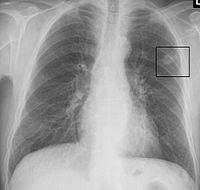
Photo from wikipedia
Objectives To evaluate the economic implications of our previous study on the use of MR-mammography (MRM) as a solitary imaging tool in women at intermediate risk due to dense breasts.… Click to show full abstract
Objectives To evaluate the economic implications of our previous study on the use of MR-mammography (MRM) as a solitary imaging tool in women at intermediate risk due to dense breasts. Background In our previous study, we found MRM to be a specific diagnostic tool with high accuracy in patients with dense breasts representing a patient collective at intermediate risk of breast cancer. For this study, we examined whether MRM is an economical alternative. Methods For the determination of outcomes and costs, a decision model based on potential diagnostic results of MRM was developed. Quality of life was estimated in a Markov chain model distinguishing between the absence of malignancy, the presence of malignancy, and death. Input parameters were utilized from the prospective TK-Study. To investigate the economic impact of MRM, overall costs in € and outcomes of MRM in quality-adjusted life years (QALYs) were estimated. A deterministic sensitivity analysis was performed. Results MRM was associated with expected costs of 1650.48 € in the 5-year period and an expected cumulative outcome of 4.69 QALYs. A true positive diagnosis resulted in significantly lower costs and a higher quality of life when compared to the consequences of a false negative result. In the deterministic sensitivity analysis, treatment costs had more impact on overall costs than the costs of MRM. The total costs per patient remained below 2500 € in the 5-year period. Conclusion MRM, as a solitary imaging tool in patients at intermediate risk due to dense breasts, is economically feasible. Key Points • In patients with dense breasts (i.e., patients at intermediate risk of breast cancer), the relative cost of MR-mammography examinations only had moderate impact on overall costs. • This is due to cost-savings through the application of a sensitive imaging technique resulting in an optimized staging and therapy planning. • MR-mammography, unaccompanied by mammography or ultrasound in patients with dense breasts, was economically feasible in our analysis.
Journal Title: European Radiology
Year Published: 2020
Link to full text (if available)
Share on Social Media: Sign Up to like & get
recommendations!